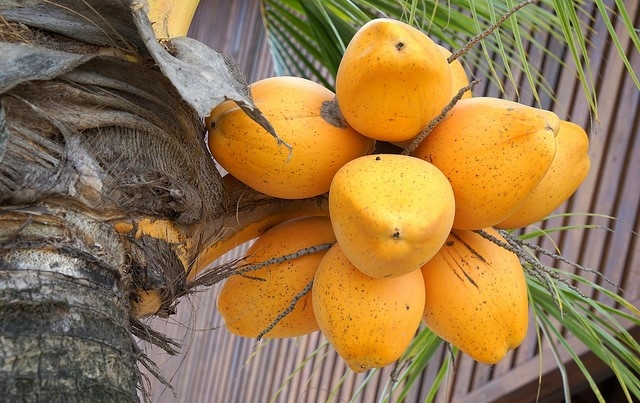
The objective of this project was to establish coconut lethal yellowing disease-free areas (CLYD-PFA) in the south of Mozambique and determine the phytosanitary measures that would be needed to declare the region a CLYD-PFA.
Coconut is one of the major crops in Mozambique and has direct influence on food security for 14-30% of rural families living in coastal areas. Approximately 62,000 tons of copra produced annually is exported or used locally for oil production and local consumption. About 50% of total coconut production is consumed locally, thereby contributing significantly to nutrition and rural income.
Mozambique's coconut industry was threatened by coconut lethal yellowing disease (CLYD), a phytoplasma disease which attacks trees and causes premature fruit fall. Coconut trees infected with CLYD can die within six months. The impact of the disease on income and employment was a major concern for the government of Mozambique.
CLYD had been confirmed in the central and northern regions of the country. However, there was no record of the occurrence of the disease in the south of River Zambezi. The project is designed to determine the phytosanitary measures that would be needed to declare the southern region a CLYD free area in order to unlock the export opportunities of coconut.
Identification and analysis of CLYD presence in the region
A study was conducted to review the existing data on vectors of the causal agents of CLYD, identify coconut production areas, define their abundance and support the development of surveys. The geographical scope of surveillance south of the Zambezi river was determined using GIS application. An aerial survey was conducted during which five suspected CLYD infected trees were detected. Ground surveys were then initiated during which 166 sites and 501 trees were sampled.
Samples collected during ground surveys were analysed by the Biotechnology Centre at Eduardo Mondlane University, Mozambique in collaboration with FAO Mozambique. The analysis consisted of molecular assays for presence of the pest in samples from coconut trees and insects (potential vectors of CLYD). CIRAD collaborated with the Biotechnology Centre for further support on the analysis and validation of the results.
The studies revealed that the incidence of CLYD is not related to soil nutrient factors. The surveys indicated low levels of CLYD presence in the south of River Zambezi at three small locations in Xai-Xai, Vilankulo, and Machanga, in Gaza, Inhambane and Sofala provinces. Only 1% of the trees tested were confirmed to be infected with CLYD. Considering the limited presence of CLYD, the designation of the area as CLYD-PFA will be premature and further tests will be necessary to develop a PFA declaration.
Built capacity on CLYD control and management
Surveillance for CLYD and knowledge of potential disease carrying vectors are critical to establish pest boundaries and eradicate the disease. Trainings were therefore a critical element of this project and solicited the full participation of stakeholders and partners in the coconut sector. Twenty-three technicians from the Ministry of Agriculture, National Plant Protection Office (NPPO), private sector and collaborating partners were trained on methodologies for effective and consistent data gathering. Training was conducted on the implementation on International Standards for Phytosanitary Measures (ISPMs) related to establishing pest free areas (ISPM No. 4) pest surveillance (ISPM No. 6) and determination of pest status in an area (ISPM No. 8).
Eighteen technicians were also trained in the identification of organisms which may act as potential vectors spreading the disease. The training sought to enable Mozambique to critically assess the levels of CLYD and foster better management and control which would eventually lead to a declaration of a disease-free area. It can also increase market access potential and improve the contribution of coconuts to food security and income generation in Mozambique.
The project team developed a manual on the identification and management of CLYD, protocols on pest records, CLYD tree sample collection for molecular tests, soil sampling and analysis. This manual was used in the stakeholder workshops and facilitated on-going work and training of personnel in the coconut industry in Mozambique.
Increased awareness on CLYD and its potential implications
Raising public awareness was an integral component of the project. Awareness campaigns, posters and leaflets were used to sensitize the public on the need for their cooperation and compliance with legal and cultural enforcement mechanisms of CLYD activities.
Prior to this project CYLD was only confirmed in the northern areas of Mozambique. With support from external experts, aerial surveillance, vector surveys and soil testing were conducted. Authorities in Mozambique became better aware of the extent of the disease and its limited presence in the southern areas of Mozambique. Though a CLYD-PFA was not possible to establish at the time, the knowledge gained would allow for better planning and action, follow up tests and greater cooperation between authorities and experts.
Further research on the disease and future work on pest management
The project results revealed only 1% presence of CLYD in the southern region with two particular strains. Further surveillance and diagnostic studies were recommended to determine the status of the disease and direct efforts towards integrated management of the disease to minimize its potential spread.
The results of the tests and surveillance indicated that several factors may be contributing to the expression of the disease symptoms. These included the possible existence of multiple stains of the pathogen in Mozambique, variability in tolerance and resistance by the types of coconuts grown as well as the vectoring capabilities of insect vectors. Further work was deemed necessary to validate these findings.
Maintaining and fostering partnerships
Throughout the project, partnerships were built to leverage competencies in the surveillance and diagnostic work on CLYD, its vectors and potential vectors. Building on the project's results, it is essential to foster these partnerships and build synergies with other projects that would sustain a long-term management strategy for the disease.